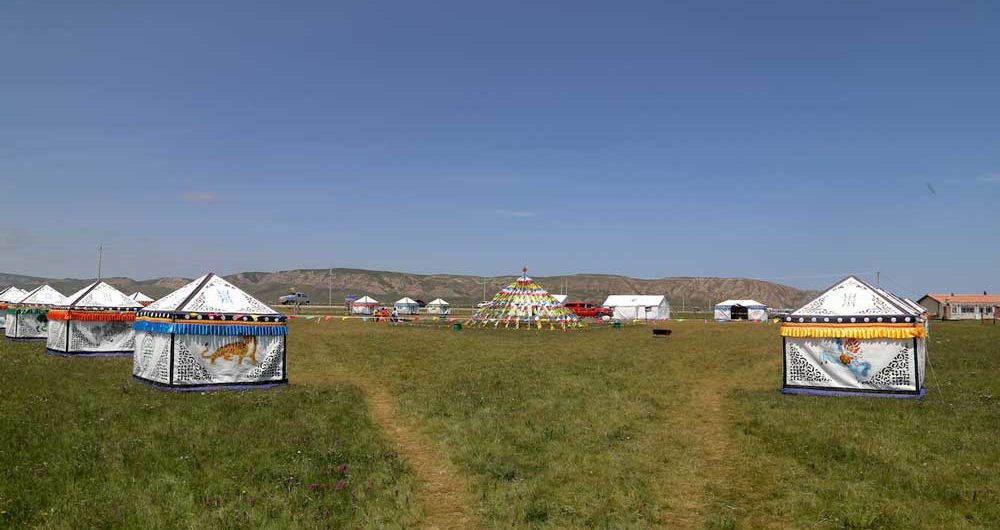My Travel Experience in Western China
I almost didn’t come this way on my China tour, but I am so glad I did. I was inspired to travel to Zhangye after seeing photos of Danxia, the rainbow mountains, while researching beautiful places in the Middle Kingdom. What I have seen and experienced in this region will stay with me forever.
My trip to China began with the popular traveller’s route from Beijing to Pingyao and Xi’an. After taking a relaxing overnight train into Lanzhou, it was immediately clear that I was off the beaten path. I bought a hash-brown cake and some friendly locals pointed me toward the bus that would take me to Lanzhou Huar Youth Hostel. A short walk from the bus stop and I found the modern art district in which the hostel is located. Thus far, it is the most interesting hostel I have stayed at in China. The establishment, like most of the buildings in the area, is a converted warehouse. Huar is affordable and the staff is very helpful, despite a limited knowledge of English. They have an elevated lounge area, spacious rooms and even a drama theatre where, if you’re lucky, you can catch a traditional opera show.
The food nearby is tasty, I had the best lamb dish just around the corner from the hostel, and you can try Lanzhou’s signature beef noodle soup all over the city. In good traffic, you can bus into the city centre in about half an hour. Here you will see a number of Muslim temples and countless jewellery and antique markets. The city has a welcoming, exciting vibe. The people are warm and happy to see a foreign face in the crowd.
A brief walk takes you to the awesome Huang He, Yellow River, where you can sit on one of several docks and enjoy the local Huang He beer. After that, walk across the metal bridge and up the hill to look over the river and city amidst beautiful foliage and White Pagoda temple. The view is peaceful and inspiring; watch as giant cranes build up the downtown area while the sun shines over the mighty current of the river. After this, head back into the centre for the street food market that opens at 6:30. Here you can enjoy all kinds of delicious barbecue and more. Everything is of the highest quality, but you can’t miss the unique milk and fermented rice drink. It should be easy to find, just look for the longest line of locals on the street! Finally, there is an opera house up the street from Lanzhou Huar Youth Hostel with four viewing rooms that you may sit in free of cost. I was lucky enough to stumble across this trip highlight on my last night in Lanzhou. Cross the street and turn right from the hostel, after about a kilometre, you will hear traditional music coming from an alley. Walk up the metal steps towards the sound of the music, choose one of the rooms and sit down. The locals will laugh as they welcome you, happy to see a foreigner appreciating the local culture. Before and after the costumed shows, staff go on stage and sing traditional songs in a karaoke format while others play traditional instruments skilfully. If you have a good time, consider buying some beer or leaving a tip, as the house doesn’t bring in much money.
Lanzhou is beautiful, a growing city in a mountainous, desert landscape with a great river flowing through it. How cool! If you have time, make sure to come this way, it is a convenient starting point into Tibetan and Uyghur China, and rewards you with a feeling of discovery for straying from the more popular tourist cities of the country.
Already more than satisfied with my decision to keep travelling West, I made my way by train to Zhangye, in the middle of Gansu province. The sights along the ride make daytime travel a must. Shining, wheat-covered mountains transition to blood red for striking landscapes that captivate for the whole five-hour journey. I got into Zhangye Qicai Danxia International Youth Hostel and was pleasantly surprised to find that the reception spoke perfect English. The rooms are clean and inexpensive. I was immediately touched by how friendly the Zhangye locals are after one man yelled out his window to point me towards the hostel, and a lady walking her dog with friends walked me to the front gate.
After checking in I walked directly across the street for dinner at the first restaurant I saw. The son-in-law of the owners, who teaches English at a local middle school, informed me that they have specialised in pig foot for over 25 years. Though the journey was pleasant, I was not eager to find another restaurant after a day in transit, and so decided that it was the perfect time to try this traditional Chinese dish. I was nervous, but it turned out to be a delicious, sticky treat. Like a giant chicken wing of tender pork! The family staff is very friendly and I ended up spending a lot of time there, talking about my home country and China. They were so surprised to hear that Canadians don’t eat pig foot.
The next day I played ping-pong with the middle school kids across the lot, then explored for a while. Outside the downtown area, the city is reminiscent of the old west, with storefronts spanning the wide and dusty streets. I came across an “ancient city” that was under construction and caught a ride back from the Zhangye Wetlands Museum on the back of a nice local’s electric scooter. The museum is in the heart of the wetlands that make the area unique. It is a beautiful wooden building filled with modern technology that teaches about the significance of the environment and Zhangye’s silk road history. Though lacking in English signs, it is within walking distance of the hostel and free. Walk around the wooden pathways outside the building through the wetland for a peaceful afternoon in a unique landscape.
The hostel offers very reasonably priced trips out to Mati Si, a temple area that I missed out on, and Danxia, the rainbow mountains that I came all this way to see. You can bus to the mountains, but if you hope to stay for the sunset (a must for the best viewing experience), you will need to cab home, costing you more than the price offered by the hostel. The mountains are stunning and entry is relatively cheap. Shuttle buses take you through four unique viewing areas, and the walking paths are manageable. If you have the energy, the hostel offers a package deal to be driven out to Mati Si in the morning, and then to Danxia in the afternoon. Try to see both, I regret missing out on the temples, but I can say with certainty that Danxia is worth the effort to see, a truly unique landform.
The people in Zhangye are so friendly. I was treated to breakfast by a man who was happy to see me playing ping-pong with the school kids, and later by the owner of the restaurant across the street. We even visited the pig butcher market before eating, an interesting experience to say the least! His wife prepared dumplings especially for me on my last night in the city and urged me to fill up for my train ride into Xinjiang. My time in Turpan is outside the scope of this post, but the small Uyghur city surrounded by grape fields is definitely worth a visit! Stay at White Camel hostel and see the Jiaohe ruins.
Initially I planned to go directly to Xining, Qinghai from Turpan, but there are no trains that go this way. Instead, I booked an overnight bus back to Gansu province to see the city of Dunhuang, where I could then bus to Xining. This was just a stop-through city to me, so I was thrilled to see the sand dunes in the distance as I approached Charley Johng’s Dune Guesthouse, a landscape that I feared I had missed out on in my travels. I admit I feel a little silly to have been surprised by the landscape, as the word dune is in the name of the place I would be staying.
I arrived out of season and was lucky to be received for a few nights, as the English-speaking owner was planning on shutting down for the season the following night. I didn’t spend a lot of time here, but enjoyed the snack street, where restaurants are labeled in English with their specialty dishes, and the nearby market, where I picked up gifts for friends and a pair of sweatpants to fight the onsetting cold. Take a little time to learn the numbers in Mandarin, as bargaining is some of the most fun you will have in China! I also had a great time riding camels in the desert on a trip organised by the hostel.
The bus ride into Xining is another beautiful trek. I wasn’t lucky enough to enjoy a sleeper, but maybe you will be! Either way, the contrast of desert and snow-capped mountains make for a memorable journey. I got into Lete Youth Hostel at around 3 AM with the help of a nice convenience store practitioner across the road. This hostel has a number of comfortable lounge areas on the fifteenth floor of a building that is ten minutes’ walk from the city enter. The staff can help you bus to trip to Qinghai Lake, the largest lake in China, or one of two mountains that are steeped in Buddhist culture. The mountains are close, but the lake takes about four hours total to reach. Though a little far out, the drive is beautiful. Along the way you can see yaks, sheep and even wild horses on the edge of snow-covered mountains. The lake is an amazing shade of blue and it’s scale is astounding.
There are several awesome food streets and markets, one near Lete hostel amid two temples, and another beside the long distance bus station where you may depart for Qinghai Hu (See things to do in Qinghai.) Make sure you try the yak milk yogurt, a sweet citrus treat that you can find all over the city. I had it for desert after every meal!
If you’re lucky you can make some Tibetan friends like I did. My friend Norbu took me in and showed me some of the best barbecue and dumpling restaurants around the city. He is the owner of a leading Tibetan tour company that offers special adventure tours in Tibet, camping and homestay with Tibetan nomads and overland Tibet trekking tours in the most remote areas of the Tibetan plateau. He is a trustworthy and friendly man, who is eager to share his love of Tibetan culture and landscapes with the world and has over eight years of experience with tourism in the region. His website, adventuresintibet.com, is the best in Tibet! I really believe he is committed to showing the best that Tibet has to offer in line with customer needs.
Now I am off to Sichuan province and hope that my trip continues to be as rewarding as it has been in the past few weeks in Gansu, Xinjiang and Qinghai. Thanks for reading, I hope this post has inspired you to travel through Western China and can help you a little bit as well!
Essential Links That May Help You:
Reservation Policy
Chinese Visa Application
Tips for a Budget Tibet Tour
Plan a Successful Tibet Tour
Tibet travel permit
About Us
Our Travel Team
Local Community Project![]()
Why Choose a Local Travel Agency
Our Privacy Policy
Tibet Group Visa
How to Visit Tibet
Trekking Adventures
Our Office Direction


Comments